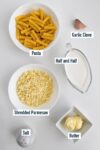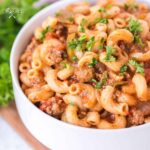While pairing bread with pasta has traditionally been part of Italian cuisine, many question whether the combination is healthy or promotes weight gain. However, bread and pasta offer nutritional benefits when enjoyed together in moderation. Though higher in calories as a duo, they form a balanced mix of carbohydrates, fiber and some protein when the right types of bread and pasta are chosen. This combo can also aid satiety due to slower digestion of the mixed macronutrients, potentially reducing subsequent snacking. When enjoying bread and pasta together, opting for whole grain bread, limiting bread quantity to 1-2 slices per serving, pairing with a vegetable-rich sauce and protein, and eating bread crusts can maximize nutritional benefits while minimizing calories.
Overall, bread and pasta make a complementary meal when enjoyed in moderation as part of a balanced diet.
Why We Should Pair Pasta With Bread?
There are several reasons why eating bread alongside pasta has traditionally been common in Italian cuisine and enjoyable meals:
- It’s traditional – Pairing pasta with bread has long been a customary part of Italian dining, passed down through generations of home cooking.
- It soaks up extra sauce – The starch in bread effectively acts as an edible sponge to absorb any leftover tomato or olive oil based sauce on the plate. This helps use all delicious components of the meal.
- It balances the pasta’s carb profile – While pasta is primarily made up of complex carbohydrates, bread provides some protein, B vitamins and fiber that balance out the pasta’s nutritional composition when enjoyed together.
- They form a complete meal – The combination of carbs from the pasta and the additional carbs, fiber and protein from bread turns the pairing into more of a complete entree that can fulfill diners when enjoyed in moderation.
Overall, the traditional and enjoyable aspects of eating bread alongside pasta stem from how bread helps use up extra sauce, balances the nutritional aspects of the primarily carbohydrate-rich pasta and transforms the duo into more of a full, balanced meal when consumed in appropriate portions.
Nutritional Impact of Pairing
When enjoyed together, bread and pasta provide complementary nutritional profiles that form a balanced combination of macronutrients – carbohydrates, protein and fiber – when consumed in proper portions:
- Carbohydrates – Pasta is comprised almost entirely of complex carbohydrates in the form of starch, providing a significant percentage of the total calories in a serving. Bread adds additional carbs from both starch and grains.
- Protein – While pasta is generally low in protein, bread contains slightly more due to gluten and other components. The protein in bread helps balance the high carb ratio of pasta.
- Fiber – Regular pasta is also low in fiber, with refined varieties containing no fiber. But many breads, especially whole grain, supply important fiber that the pasta lacks. This balances their overall composition.
Together in moderate servings, the combination of pasta and bread helps fulfill dietary requirements for carbohydrates and CFG – carbohydrates, fat and protein. For example, a 330 calorie serving of penne pasta with 80 calories worth of whole wheat bread supplies:
- 57 grams of carbs
- 13 grams of protein
- 3 grams of fat
- 4 grams of fiber
This provides a balanced ratio of around 55% carbs, 15% protein and 30% fat. While higher in calories as a combined meal, the pairing represents a well-rounded balance of macros that can fit into a healthy diet when enjoyed in appropriate portions – with the bread helping boost pasta’s limited protein, fiber and vitamins. But overindulging in too many carbohydrates at one sitting remains unhealthy.
In moderation, pairing bread and pasta can provide a complementary nutritional profile higher in balanced macros due to the balance of components bread adds to the primarily carbohydrate-rich pasta. But proper serving sizes must still be observed.
Potential Benefits for Satiety
While pairing bread with pasta increases the carbohydrate content and calories of the combined meal, research suggests the combination may provide benefits for feelings of fullness and subsequent appetite:
- More filling – Though higher in total calories, the mixture of carbohydrates from the pasta, additional carbohydrates and fiber from the bread, and some protein from bread makes the pairing more filling and satisfying than pasta alone.
- Slower digestion – The complex carbohydrates in pasta require slower digestion, and the fiber and protein in bread further slow absorption. This contributes to the ability of the meal to keep diners feeling full.
- Blood sugar control – The balanced mix of quickly and slowly digested components helps control blood sugar spikes after eating, with the fiber from bread assisting in this impact. This subsequently aids satiety.
- Less snacking – The feeling of fullness derived from the complementary nutritional components in bread and pasta may reduce desires for calorie-dense snacking afterward due to better appetite control.
Some preliminary studies have shown that meals with a balanced macronutrient ratio of around 30% protein, 30% fat and 40% carbohydrates tend to be the most filling and satisfying. Pairing bread with pasta moves the combined menu closer to this composition. For example:
Without bread:
330 calories serving of penne pasta contains:
- 75 grams of carbs
- 5 grams of protein
- 1 gram of fat
With 2 slices whole wheat bread:
330 calories plus 160 bread calories equals 490 calorie meal containing:
- 90 grams of carbs
- 18 grams of protein
- 8 grams of fat
This balanced ratio of 45% carbs, 20% protein and 35% fat appears to promote fullness and reduce hunger more effectively compared to pasta alone, potentially contributing to reduced desires for energy-dense, unhealthy snacks afterward. Though higher in calories, the pairing appears tailored to trigger satiety.
Guidelines for Healthier Pairing
While pairing bread and pasta can provide benefits when enjoyed in moderation, following certain guidelines can maximize the nutritional value and minimize the calories of the combination:
- Choose whole wheat bread – Replacing white bread with whole wheat provides more fiber, B vitamins, minerals and antioxidants. The fiber further aids satiety.
- Limit bread quantity – Restrict bread consumption to 1-2 slices per serving of pasta. More than this often overindulges carbohydrates while providing minimal additional nutritional value.
- Pair with vegetable-rich sauce – Topping pasta and bread with a marinara sauce packed with ingredients like carrots, zucchini, and mushrooms introduces valuable nutrients, fiber and antioxidants to the meal.
- Include a protein source – Consuming a protein food along with bread and pasta, such as beans, lean meat or eggs, forms a more balanced meal composed of all macronutrients. This aids satiety and nutrition.
- Eat the bread crusts – The outer crusts of bread are highest in fiber, many B vitamins, minerals and trace nutrients. Including them maximizes the nutritional density of the bread.
- Limit added fats – While some added fats can benefit a meal, going easy on high-fat condiments like butter helps minimize excess calories consumed alongside the naturally high-carb pairing of pasta and bread.
The specific combination of bread and pasta consumed also impacts the overall healthiness of the pairing. For example: 330 grams of whole wheat penne pasta with:
- 2 slices whole wheat bread
- Provides 68 grams of carbs, 15 grams of protein
- Contains 12 grams of fiber and valuable nutrients
- Marinara sauce packed with vegetables
- Supplies antioxidants, vitamins and minerals
- 100 grams of chickpeas
- Provides fiber, protein, iron and other nutrients
- A drizzle of olive oil for added healthy fat
Following these guidelines – choosing whole grain bread, restricting quantity, pairing with vegetable sauce and protein, and utilizing the bread crusts while limiting added fats – transforms the classic combination of bread and pasta into a healthier, balanced meal that maximizes the benefits of eating the duo together while minimizing the potential downsides of excess carbohydrates.
Potential Downsides
While pairing bread with pasta can provide benefits when done in moderation, there are a few potential downsides to consider:
Higher calorie meal – Overindulging and consuming large portions of both bread and pasta can cause the combined meal to contain excess calories that exceed daily limits.
Reduces benefits of lower-carb pasta – Enjoying very large amounts of bread alongside pasta may decrease some of the health benefits of choosing lower-carb varieties of pasta.
Easy to overeat – The carbs in both bread and pasta are highly palatable, making it easier to unintentionally consume too many carbohydrates when enjoying the combination.
These main concerns relate to how pairing bread and pasta inherently increases the carbohydrate content and calories of the combined meal. Though balanced nutrition can result in proper portions, overindulgence causes the downsides to outweigh benefits. Following guidelines for moderating bread quantity, choosing whole grain options, and including non-starchy sides can help manage potential pitfalls. But ultimate responsibility lies with the consumer.
While pairing bread with pasta provides benefits like balanced nutrition, fullness and reduced snacking when enjoyed in moderation, overindulgence can cause the combined meal to contain excess calories and carbohydrates that outweigh benefits. Following guidelines for healthier combinations centered around whole grains, vegetables, proteins and limited quantities can maximize benefits and minimize downsides when eating bread alongside pasta.
FAQs
1. Can diabetics eat pasta and bread together?
Yes, but pair a moderate portion of whole grain pasta and bread with plenty of non-starchy vegetables and lean protein to manage the impact on blood sugar.
2. Does eating bread with pasta make you fat?
Consuming excess calories from overeating the pairing can promote weight gain, but eating moderate portions as part of a balanced diet should not cause weight gain in isolation.
3. Is eating bread with pasta unhealthy?
In moderation as part of an otherwise healthy diet, the pairing provides balanced nutrition. But large portions constitute an unhealthy amount of carbohydrates.
4. How much bread should you eat with pasta?
Limit bread intake to 1-2 slices per serving of pasta for balanced nutrition while minimizing excess calories. Any more provides minimal additional value.
5. Can I eat bread after pasta?
While pairing the two together provides benefits, eating bread separately after a meal of pasta alone is acceptable though may not be as nutritionally complementary.




